DURABOOK S15
The thinnest, lightest laptop in its (15.6-inch semi-rugged) class gets a big tech and performance upgrade, at a very affordable price
(by Conrad H. Blickenstorfer; photography by Carol Cotton)
There's been a lot of talk over the past decade that we are now in a "Post PC" era where conventional personal computers have been relegated into near insignificance and replaced by phones, tablets and the cloud. It's true that there are now literally billions of smartphones, probably over a billion tablets, and cloud computing is on the up and up. But there are also still well over a billion Windows PCs. Hundreds of millions of workers around the world didn't suddenly replace their PCs and laptops with tablets and handhelds.
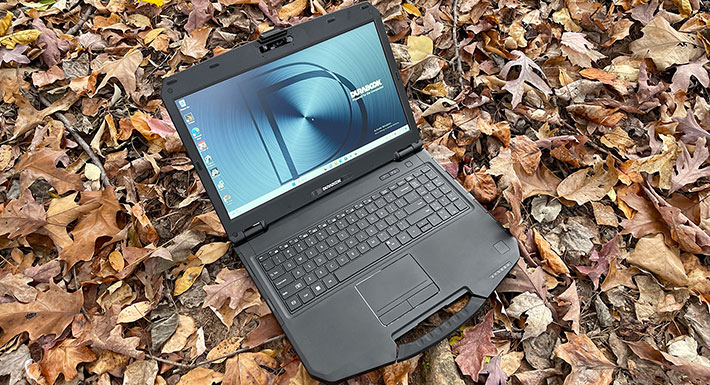
Even out in the field where ruggedness matters, Windows laptops are holding their own. As everyone knows, Windows works best on larger screens. And that is exactly where the 15.6-inch semi-rugged DURABOOK S15 laptop comes in. This budget-friendly workhorse has just undergone a thorough tech update. Who makes DURABOOKs? That'd be Twinhead International Corporation in Taiwan, a company with decades' worth of experience in making rugged laptops and tablets. And Durabook Americas is their North American market subsidiary.
The DURABOOK S15
As of November 2023, Durabook's lineup of ruggedized laptops consists of three models, the semi-rugged DURABOOK S14I and S15, and the fully-rugged DURABOOK Z14I. Each is a distinctly different design. We have conducted full reviews of both the S14I (see here) and the Z14I (see here), and examine the S15 in this review. The table below to the right shows some of the major specs and differentiators between the three most recent full-size DURABOOKs:
|
|
|
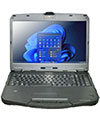
|
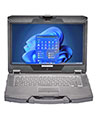
|
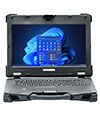
|
|
|
DURABOOK model
|
S15
|
S14I
|
Z14I
|
|
|
Size (inches)
|
14.76 x 10.75 x 1.16
|
13.88 x 11.10 x 1.50
|
14.02 x 11.02 x 1.97
|
|
|
Weight
|
5.73 lbs
|
5.07 lbs
|
7.93 lbs
|
|
|
Intel Processor
|
Alder Lake (G12)
|
Tiger Lake (G11)
|
Tiger Lake (G11)
|
|
|
Thermal Design Power (TDP)
|
15/55 watts
|
12/28 watts
|
12/28 watts
|
|
|
Cooling
|
Active (fan)
|
Active (fan)
|
Passive
|
|
|
Display size (inches)
|
15.6 (1920 x 1080)
|
14.0 (1920 x 1080)
|
14.0 (1920 x 1080)
|
|
|
Luminance
|
1000 nits (opt.)
|
1000 nits (opt.)
|
1000 nits
|
|
|
Main Battery capacity
|
56.2 watt-hours
|
50.8 watt-hours
|
74.5 watt-hours
|
|
|
2nd Battery capacity
|
NA
|
51 watt-hours
|
87 watt-hours
|
|
|
Std. battery life
|
12 hrs.
|
10 hrs.
|
12.5 hrs.
|
|
|
Drop spec
|
4 feet
|
4 feet
|
6 feet
|
|
|
Sealing
|
IP5X
|
IP53
|
IP65
|
|
|
Starting price
|
US$1,699
|
???
|
???
|
The trend in rugged laptops over the past several years has seen a focus on larger displays in the 14 to 15.6 inch class, generally with full HD 1920 x 1080 pixel resolution available at least as an option. The older 1366 x 768 format is still the default in some models, but generally customers are moving to higher resolutions.
Compared to rugged laptops of the past, newer designs have become progressively slimmer, with profiles usually measuring from less than two inches and down to as little as just over an inch. Weight has also decreased, primarily due to a switch from bulkier hard disks to much smaller solid state storage, and also due to higher density batteries that take less space.
What's the overall difference between the two semi-rugged and the fully-rugged DURABOOK models? It's not performance; it's primarily how resistant they are to environmental impacts in the field, and how well they are sealed against dust and liquids.
It's not easy keeping up with the very rapid progress in processor and storage technology, but DURABOOK has done a commendable job in keeping their product lines up-to-date.
At this point, DURABOOK's two 14-inch models use ultra-low voltage Intel "Tiger Lake" 11th generation quad-core processors with 12/28 watt thermal design power where 28 watts represents the maximum amount of heat the computer must be able to get rid of, and it's also used by Intel as a rough performance indicator. Although no longer the latest, 11th gen Tiger Lake chips remain competent, reliable performers.
The newly updated S15, however, uses "hybrid" processors from Intel's "Alder Lake" 12th generation of CPUs with a 15/55 watt TDP rating. That doesn't mean the chips run hotter, it's just that Intel came up with a new way of rating these types of chips. "Alder Lake," however, IS different in that 12th generation chips include two different types of pressing cores, power and economy (we'll get more into that technology later). Definitely a step forward.
Design, look and feel
DURABOOK's marketing materials proudly describe that with a thickness of just over an inch and a starting weight of 5.73 pounds, the S15 laptop is the "thinnest and lightest in its class," that class being semi-rugged laptops with 15.6-inch displays. By comparison, the fully-rugged Getac X600 with a 15.6-inch screen is 2.1 inches thick and its starting weight is 9.7 pounds. So 5.7 pounds is remarkably little for a tough full-size notebook, and we're sure many customers will appreciate that, as well as the S15's slender profile. And they will also appreciate the S15's very reasonable $1,699 starting price. That's actually $300 less than that of the S15AB we tested a few years ago. And it is considerably less than what fully-rugged notebooks cost.
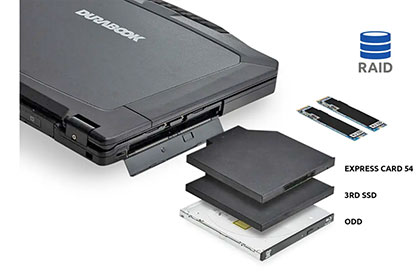 That makes the DURABOOK S15 a great bargain. It does, of course, entirely depend on what one is looking for. The S15 is an impressive full-size notebook computer designed to be considerably tougher and more durable than standard consumer notebooks, but without the extra heft and cost and greater protection of a fully rugged design. And for that it is a bargain indeed.
That makes the DURABOOK S15 a great bargain. It does, of course, entirely depend on what one is looking for. The S15 is an impressive full-size notebook computer designed to be considerably tougher and more durable than standard consumer notebooks, but without the extra heft and cost and greater protection of a fully rugged design. And for that it is a bargain indeed.
Compared to fully-rugged laptops like, for example, the company's Z14I, the S15 is only spill-proof rather than fully waterproof, and it's designed and built to be tough enough for its intended deployments rather than totally bullet-proof like a tank. The S15 does have a strong magnesium-alloy case, a bright and pleasant-to-use 15.6 inch display that is considerably larger than those of most fully rugged notebooks, and it comes with all the connectivity and functionality expected from a state-of-the-art machine in this class. Under the hood works one of three available powerful but efficient 12th generation Core processors. And despite its slender profile, the S15 has a media bay on its left side that can accommodate either additional storage, an ExpressCard54, or even an increasingly rare (but often still needed) optical drive.
Despite being a full-size laptop with a big screen, the S15 feels remarkably light and handy, with part of that coming from the nicely integrated carry handle. The S15 isn't a big, unwieldy block like older semi-ruggeds used to be. It is a clean and elegant design that sports a new all-black look. And there is no also a big DURABOOK logo where in the last S15 we had in the lab, there wasn't one.
Below you can see the DURABOOK S15 from the top and all four sides. The magnesium alloy case is remarkably light, yet, the company points out, many times stronger than ABS plastic. And despite its full-size form factor, the S15 doesn't flex and creak like many plastic consumer laptops do. The LCD case hinges have a trust-inspiring degree of resistance when opening and closing the laptop. And when you close the lid, a small spring-loaded metal latch snaps into place, securing the LCD case in its closed position. To open the notebook again, you push on the latch.

Ports and connectivity are located on the right and rear of the computer. Unlike the original S15 that had almost all of its ports fully exposed, the new S15 uses protective plastic port covers all around. These are not of the water-sealing kind; they are there for physical impact protection.
On the right side, from left to right, is the optional Smart Card reader, a standard audio in/out combo jack, an SD card reader that can handle SDXC cards (which have a theoretical limit of 2TB) as well as Micro-SD cards via adapters, two fast USB 3.2 Gen2 Type-A ports, a SIM card slot under a screw-on cover, and then the power plug.

Along the backside, again from left to right, there is a RJ45 gigabit Ethernet jack, a Thunderbolt 4 port, a USB 3.2 Gen2 Type-C port with DisplayPort support, an HDMI port, a 15-pin VGA port, and a legacy DB9 RS232/422/485 COM port

The front features the nicely designed and fully integrated rubber handle, as well as the unit's two speakers and a bank of annunciator LEDs.
Below is a look at the bottom of the DURABOOK S15 with the battery and its two large access covers removed. Both aluminum covers are held in place with a number of small Philips head screws. One of the two covers has air vents, again indicating that this is a spill-resistant rather than a water-tight design. With the covers removed it becomes immediately obvious that while this latest S15 looks very much like its predecessors, it is in fact an entirely new design with a completely different board and chassis layout. We're very impressed with the very solid magnesium-alloy build of S15, something you don't necessarily expect given the laptop's modest (for a rugged unit) starting price.
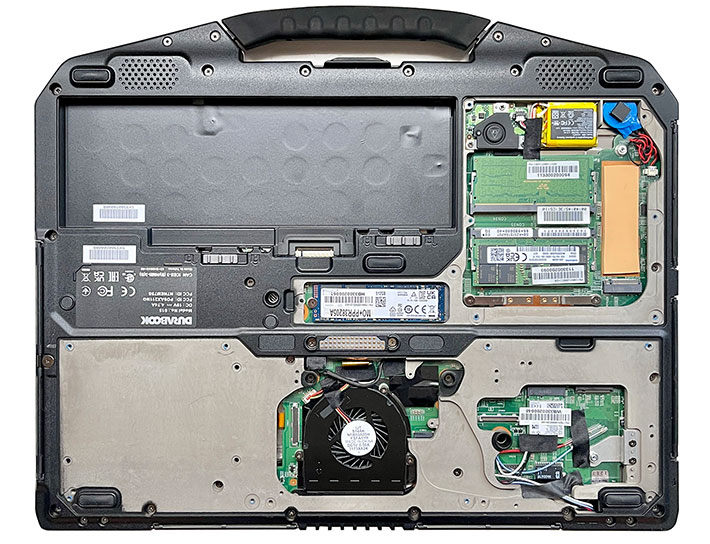
The compartment in the upper right is the general area where earlier S15's had their hard disk and later 2.5-inch solid state disk. Those have been replaced with much smaller storage modules. Today, the compartment provides easy access to the laptop's dual SO-DIMM RAM sockets, populated in our evaluation unit with 32GB Samsung DDR5 PC5-4800 modules (not all the competition has made the step to DDR5 yet). To the right of the RAM storage, there is a PCIe NVMe socket, unused in our unit, for secondary storage, which makes RAID 0 (striped for superior performance) and RAID 1 (mirrored for real-time backup) support possible. Also in this compartment are the small clock battery and the 1.1 watt-hour backup battery for swapping the main battery. Another cutout in the chassis, in the center of the unit, houses the primary PCIe NVMe storage module.
The large compartment in the bottom provides access to the computers's Intel Wi-Fi 6E AX211 LAN and Bluetooth module. Next to it is the socket for an optional 4G LTE/GPS or 5G mobile broadband module.
Also in that compartment, in the center, is the S15's small cooling fan. This is one area where the "semi-rugged" S15 differs from heavier and more expensive "fully" rugged systems. Their fan-based active cooling has the fan siting in its own compartment that is completely sealed away from the interior of the laptop. Another design detail, by the way, is that the compartment covers don't have sealing gaskets as they would have in a sealed fully-rugged unit.
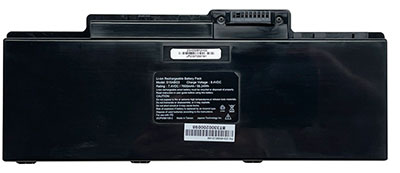 On the left you can see the S15's 7.4 Volt/7,600mAH 56.24 watt-hour Lithium-Ion battery that's only 3/8th of an inch thick. It neatly snaps flush into the back of the system and is secured in place by a couple of sliders.
On the left you can see the S15's 7.4 Volt/7,600mAH 56.24 watt-hour Lithium-Ion battery that's only 3/8th of an inch thick. It neatly snaps flush into the back of the system and is secured in place by a couple of sliders.
DURABOOK has been going up and down in battery capacity over the life of the S15 series. The line started with a small netbook-style snap-in battery, then switched to a massive one in the S15H a few years ago, then went back to the current medium-capacity thin format with this latest S15 and its predecessor. DURABOOK's specs indicate 12 hours battery life for this unit.
We didn't disassemble the DURABOOK S15 any further. Even a brief look inside the two service compartments reveals the high degree of quality and design/manufacturing expertise that went into the magnesium-alloy chassis and case of this laptop, something we've come to expect from a company that has decades' worth of experience in designing and manufacturing rugged laptops.
We did, however, use our lab's FLIR ONE Pro thermal camera that visually depicts surface temperature to see how the DURABOOK S15 dissipates the heat generated by its powerful 15/55 watt U-Series processor and related circuitry. The images below were taken while the S15 was running the PCMark 10 benchmark. On the left we're looking down onto the keyboard, and here we're seeing a maximum surface temperature of just 94.8F, not even human body temperature. On the right, a look at the exhaust of the fan/heat exchanger, and here we're seeing a maximum of 125F, which is not excessive.
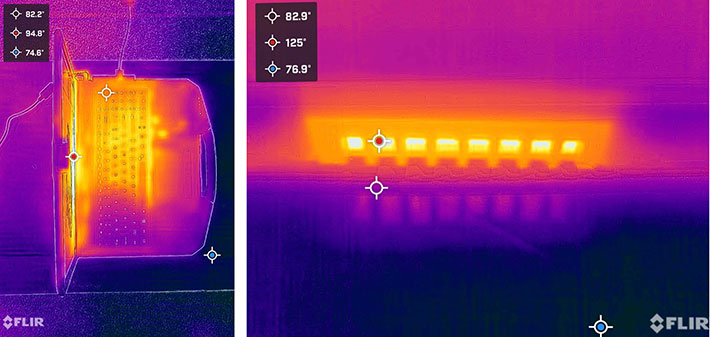
Keyboard and touchpad
The latest DURABOOK S15 has a redesigned keyboard. It is still, of course, full-scale, but it now has 96 instead of 86 keys, due to the integration of a full numeric keypad. 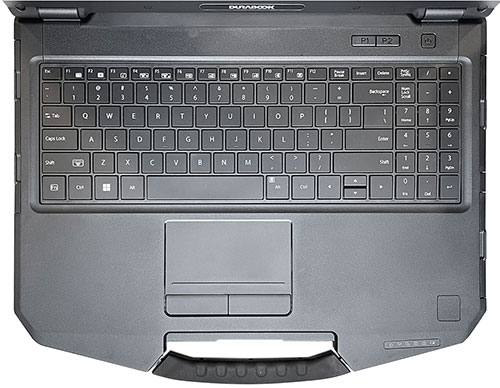 How did they find the space for the extra keys? Mostly by reducing the margin to the left and right of the keyboard.
How did they find the space for the extra keys? Mostly by reducing the margin to the left and right of the keyboard.
The S15 key design changed over the years as well. This latest version uses a standard membrane "island-style" design optimized for functionality, clarity and ease of use. The design looks and feels much like an Apple keyboard, neat and clean, and we like it a lot.
The keys are black with thin white letters, numbers and symbols. Fonts, font weight and overall design are all uncluttered and elegant, and look great. The keyboard has an optional backlight that toggles on and off.
Below the keyboard is the unit's 4 x 2 inch capacitive touch pad. It is a properly sized and slightly recessed design with two large and very responsive mouse buttons in front of it. The touch pad is a pleasure to use, and unlike the one in the S15AB we tested a few years ago, can be operated with gloves on. Perhaps not very thick ones, but it works nicely with most thinner glove materials.
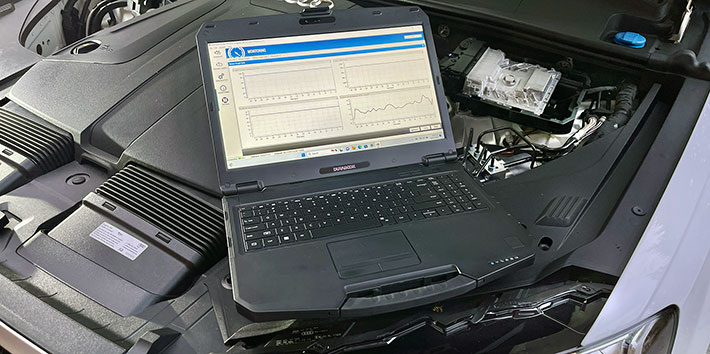
Intel "Alder Lake" 12th gen Core processor performance
DURABOOK scored a coup when the company announced its fan-cooled R11 rugged tablet computer on July 26, 2022 — the R11 was the first fully rugged tablet available with Intel "Alder Lake" 12th generation Core processors. In the hyper-competitive market for state-of-the-art rugged laptops and tablets, being first to market with new technology can sway purchase decisions and give a company an edge and competitive advantage. A good year later, the same two "Alder Lake" processors are now available in the updated S15.
|
2023 DURABOOK S15: Processor Options
|
|
Available DURABOOK U11 CPUs
|
Intel Core i5
|
Intel Core i7
|
|
Model
|
1235U
|
1255U
|
|
Model Code
|
12th gen Alder Lake
|
12th gen Alder Lake
|
|
Lithography
|
Intel 7
|
Intel 7
|
|
Performance cores
|
2
|
2
|
|
Efficient cores
|
8
|
8
|
|
Max turbo speed
|
3.30/4.40 GHz
|
3.50/4.70 GHz
|
|
Thermal Design Power (TDP)
|
15/55 watts
|
15/55 watts
|
|
Smart Cache
|
12MB
|
12MB
|
|
Integrated graphics
|
Intel Iris Xe
|
Intel Iris Xe
|
|
Execution Units
|
80
|
96
|
|
Graphics max speed
|
1.20 GHz
|
1.25 GHz
|
Note that "Alder Lake" is more than just another Intel chip generation. It is Intel's first major "hybrid" processor design, combining large, powerful performance cores ("p-cores") and smaller, simpler economy cores ("e-cores"). Why using two types? Because it's not energy-efficient to use high-performance cores for routine or background work. Smartphones, both on the iPhone and the Android side, have been using different cores for different work for years.
So with Alder Lake, Intel brings, for the first time, combinations of p-cores and e-cores into its processors. For the p-cores, Intel used a new high-end microarchitecture called Golden Cove for a nice average 18% performance boost over comparable cores in the prior generation of Core processors. On the e-core side it is basically frugal Intel Atom processor technology, also with a new microarchitecture named Gracemont. According to Intel, each Gracemont e-core is capable of as much or more performance than one of Intel's high-end 6th generation "Skylake" cores, at much lower power consumption.
How does the combination of p-cores and e-cores work? The concept is to route heavy-duty, time-critical work to the p-cores and simpler tasks of lesser importance to e-cores.  To make that work, Intel and Microsoft cooperatively created "Thread Director," a technology that continuously analyzes the processing workload and determines what goes to which type of core. Only Windows 11 includes the complete thread director capabilities, which is why Alder Lake-based computers pretty much need Windows 11 to get the full benefit of this new hybrid CPU architecture.
To make that work, Intel and Microsoft cooperatively created "Thread Director," a technology that continuously analyzes the processing workload and determines what goes to which type of core. Only Windows 11 includes the complete thread director capabilities, which is why Alder Lake-based computers pretty much need Windows 11 to get the full benefit of this new hybrid CPU architecture.
 How all of this thread directing works goes well beyond the scope of this review (see RuggedPCReview's more detailed explanation here). The underlying concept is sound, as has been shown in literally billions of smartphones equipped with such hybrid chips. In essence, the S15 platform's jump from 8th to 12th generation Intel chips means going from four general purpose cores (and eight threads) to two power cores and eight efficiency cores for a total of ten cores and 12 threads.
How all of this thread directing works goes well beyond the scope of this review (see RuggedPCReview's more detailed explanation here). The underlying concept is sound, as has been shown in literally billions of smartphones equipped with such hybrid chips. In essence, the S15 platform's jump from 8th to 12th generation Intel chips means going from four general purpose cores (and eight threads) to two power cores and eight efficiency cores for a total of ten cores and 12 threads.
 DURABOOK S15 customers have their choice of either a Core i5-1235U or a Core i7-1255U processor. Both have two dual-threaded p-cores and eight single-threaded e-cores. The difference between the two seems minor, with the i7-1255U running at slightly higher clock speeds and having 96 graphics execution units compared to the i5-1235U that must make do with 80 graphics execution units. The graph to the right shows the different behavior of the two p-cores compared to the eight e-cores while running a benchmark.
DURABOOK S15 customers have their choice of either a Core i5-1235U or a Core i7-1255U processor. Both have two dual-threaded p-cores and eight single-threaded e-cores. The difference between the two seems minor, with the i7-1255U running at slightly higher clock speeds and having 96 graphics execution units compared to the i5-1235U that must make do with 80 graphics execution units. The graph to the right shows the different behavior of the two p-cores compared to the eight e-cores while running a benchmark.
Do note that the cooling fan-quipped DURABOOK S15 laptop and R11 rugged tablet come with 15/55 watt U-Series Alder Lake processors, while the fanless DURABOOK U11 tablet uses 9/29 watt U-Series processors. That's because more watts means more power but also more heat that must be dissipated.
To see what kind of performance the DURABOOK S15 provides with the Core i7-1255U processor our evaluation unit came with, we ran our standard benchmark suites, Passmark Software's PerformanceTest version 6.1 and 9.0, PCMark 10, 3DMark, GeekBench 5, as well CrystalMark for confirmation and single core performance information.
The table below shows how the updated DURABOOK S15 compares to the company's own fan-based semi-rugged S14I and fanless fully-rugged Z14I laptop, as well as to two major semi-rugged competitors, the Getac S410 and the Panasonic 55 Mk2:
The results are as follows:
|
DURABOOK S15 Benchmarks and Comparisons
|
|
Manufacturer
|
DURABOOK
|
DURABOOK
|
DURABOOK
|
Getac
|
Panasonic
|
|
Model
|
S15
|
S14I
|
Z14I
|
S410 G5
|
55 Mk2
|
|
Device class
|
Semi-rugged
|
Semi-rugged
|
Fully-rugged
|
Semi-rugged
|
Semi-rugged
|
|
Year tested
|
2023
|
2021
|
2021
|
2023
|
2021
|
|
CPU Type: Intel
|
Core i7
|
Core i7
|
Core i7
|
Core i5
|
Core i7
|
|
CPU Model and gen
|
1255U (12th)
|
1165G7 (11th)
|
1165G7 (11th)
|
1350P (13th)
|
1185G7 (11th)
|
|
Thermal Design Power (TDP)
|
15/55 watts
|
12/28 watts
|
12/28 watts
|
28/64 watts
|
12/28 watts
|
|
BatteryMon min draw
|
4.2 watts
|
5.5 watts
|
6.1 watts
|
3.8 watts
|
3.3 watts
|
|
PassMark 6.1
|
8,185
|
10,338
|
8,789
|
9,503
|
5,792
|
|
PassMark 9.0
|
5,882
|
5,164
|
4,800
|
6,392
|
4,965
|
|
CrystalMark
|
424,336
|
455,646
|
463,662
|
567,485
|
503,390
|
|
PCMark 10 Overall
|
5,568
|
4,570
|
4,623
|
5,710
|
4,904
|
|
PCMark 10 Drive
|
1,785
|
793
|
944
|
1,817
|
1,326
|
|
3DMark Time Spy
|
1,624
|
1,040
|
1,232
|
1,685
|
1,160
|
|
GeekBench 5 Single
|
1,163
|
1,496
|
1,391
|
1,622
|
1,484
|
|
GeekBench 5 Multi
|
6,471
|
3,640
|
4,088
|
9,136
|
4,560
|
|
GeekBench 5 Open CL
|
17,404
|
12,350
|
12,168
|
16,815
|
12,745
|
What can we learn from these benchmarks? First that the days of massive performance differences between Intel processor generations are over. Sure, there is still significant progress from one processor generation to the next, but it's no longer about drastic increases in clock speed or truly fundamental innovations. While the switch to hybrid processors is certainly noteworthy, that's more of a different approach than a big step forward.
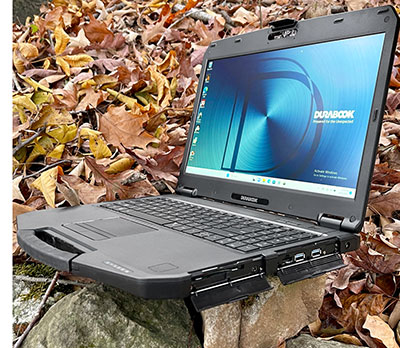 Does that mean processor generations are becoming less relevant? To an extent, yes, but there still is innovation. There's support for new technologies and new versions of technology. There's fine-tuning. There's a lot of tinkering with naming and definitions and all the special technologies Intel likes to bake into chips.
Does that mean processor generations are becoming less relevant? To an extent, yes, but there still is innovation. There's support for new technologies and new versions of technology. There's fine-tuning. There's a lot of tinkering with naming and definitions and all the special technologies Intel likes to bake into chips.
Second, and that's actually not shown in the above table, all else being equal, there is a noticeable performance difference between fan-cooled and passive-cooled designs. Durabook believes that each approach has its merits. Fully sealed fanless systems eliminate the noise, potentially unwanted air movement, and failure potential of a mechanical fan, but at the cost of slightly throttled performance, because passive cooling just can't keep the same close control over operating temperatures as fans can. So in Durabook's lineup, the Z14i laptop and the R8 and U11 tablets are fanless, whereas the S14I and S15 laptops and the R11 tablets have fans.
Third, there's amazing performance parity in Tier One systems. Everyone is on fast PCIe NVMe solid state disks now (though we're still seeing fairly large performance differences among PCIe SSDs). Pretty much all competitors are at least on 11th gen processors. Given that 13th gen "Raptor Lake" chips are now becoming available in Tier One rugged systems, it'd have been nice to see the S15 equipped with Raptor Lake, but one can't have everything in budget-friendly tech.
Overall, the benchmarks show that this latest DURABOOK S15 is an satisfyingly strong performer, even against machines that can cost several thousands more.
Do note, however, that like almost all recent rugged mobile Windows systems we've tested, performance while plugged in will be different from performance running on battery. That's because manufacturers can optimize the performance versus power draw balance for different operating conditions.

The two graphs above show the S15 running the PCMark 10 benchmark plugged in (left) and on battery (right). You can see that when plugged in, the clock frequency vacillates between roughly 1500MHz and 4000MHz, whereas on battery, it vacillates between 1500 and just 3100MHz, using less power and generating less heat. So on battery, performance is a bit lower, but the system will generate less heat and use less battery.
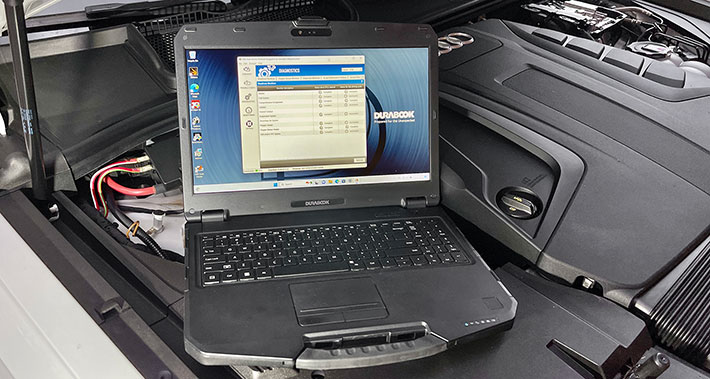
Power and battery life
Back in the days when the first rugged laptops appeared, the battery life of laptop computers was in the 1-2 hour range, and even when we launched RuggedPCReview.com back in 2005, we rarely saw more than 3-4 hours. Today's customers generally expect full-shift operation, and manufacturers deliver. How far we've come.
That said, it wasn't easy. While battery technology has come a fairly long way, it has not kept pace with the far more dramatic increases in processing power. And today's customers want their laptops and tablets sleek and light, and that again is a problem because batteries are quite heavy.
So how does all of this affect the DURABOOK S15? Well, over time the company has tried different approaches with the big-screen S15 platform. The original 6.5-pound DURABOOK S15C, launched in 2011, had a small 48 watt-hour that only yielded about 3.5 hours of operation. The DURABOOK S15H we tested in 2014 came with a much beefier 87 watt-hour battery that lasted more like 7.5 hours. That was progress, but the machine still weighed a hefty 6.6 pounds and was an inch and a half thick. The S15AB we analyzed in 2016 came with a 59 watt-hour battery and weighed in at 5.7 pounds. Now, the latest S15's hybrid processors provide higher performance at lower battery power draw.
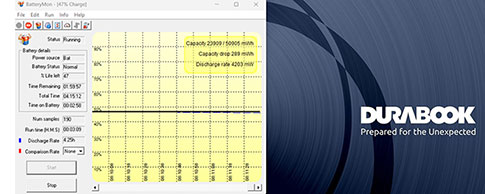 We tested the power draw of the S15 with our standard BatteryMon benchmark. With the Windows 11 Power setting set to "Best Power Efficiency" and the display backlight set to its lowest setting, we saw a minimum draw of about 4.2 watts. That's theoretically good for 13.3 hours, a bit more than the company's 12 hour estimate.
We tested the power draw of the S15 with our standard BatteryMon benchmark. With the Windows 11 Power setting set to "Best Power Efficiency" and the display backlight set to its lowest setting, we saw a minimum draw of about 4.2 watts. That's theoretically good for 13.3 hours, a bit more than the company's 12 hour estimate.
|
DURABOOK S15 BatteryMon Power Draws (at idle)
|
|
|
Backlight level
|
Darkest
|
50%
|
Brightest
|
|
|
Max Battery
|
4.2 watts (13.3 hrs.)
|
5.6 watts (10.0 hrs.)
|
12.1 watts (4.7 hrs.)
|
|
|
Max Performance
|
4.5 watts (12.4 hrs.)
|
5.9 watts (9.5 hrs.)
|
12.5 watts (4.5 hrs.)
|
With the backlight set to roughly 50% for comfortable indoor viewing, we saw a minimum of 5.6 watts, theoretically good for ten hours. And with the backlight set to maximum brightness, power draw went up to 12.1 watts, theoretically good for 4.7 hours. We then switched the Windows 11 Power setting set to "Best performance." That way, with the display backlight set to its lowest setting, we saw only a very slightly higher minimum of about 4.5 watts. With the backlight set to 50% for comfortable indoor viewing, we recorded 5.9 watts, almost the same also. And with the backlight set to maximum brightness, power draw was 12.5 watts, theoretically good for 4.5 hours.
Real-world mileage will depending on many variables. Measuring minimum draw in a test lab is not an accurate predictor of actual battery life. As far as real world battery life goes, PCMark 10's Battery test shows how long a charge lasts with the system never sleeping and constantly being exercised with a variety of typical tasks. In that test, the latest DURABOOK S15 scored a 7:08 hours, not the twelve hours in the specs, but respectable for the system running at uninterrupted load.
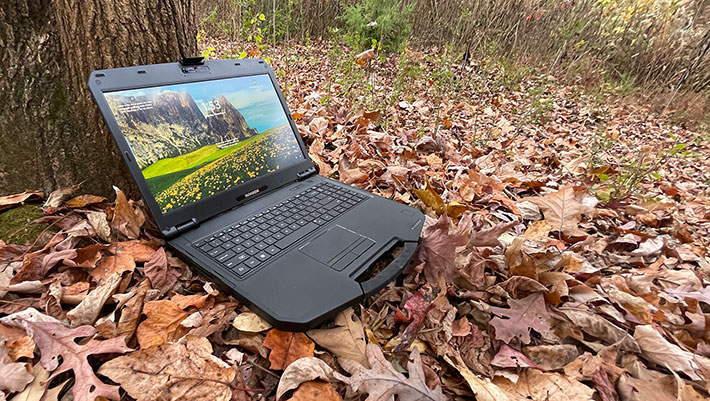
Very good display
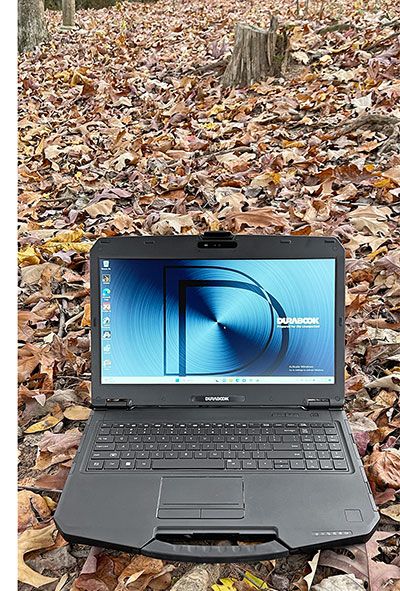 The DURABOOK S15's large display measures 15.6 inches diagonally and it uses the "full HD" 1920 x 1080 pixel resolution, which translates into a wide-format 16:9 aspect ratio. 1920 x 1080 resolution in this size display makes for 141 pixels per inch. Full HD is still pretty much the norm in semi-rugged and fully-rugged laptops. Given the very high pixel density of today's smartphones and consumer tablets, as well as the 4k resolution of many PC monitors and almost all TVs, we hope to soon see higher resolution on professional laptops as well.
The DURABOOK S15's large display measures 15.6 inches diagonally and it uses the "full HD" 1920 x 1080 pixel resolution, which translates into a wide-format 16:9 aspect ratio. 1920 x 1080 resolution in this size display makes for 141 pixels per inch. Full HD is still pretty much the norm in semi-rugged and fully-rugged laptops. Given the very high pixel density of today's smartphones and consumer tablets, as well as the 4k resolution of many PC monitors and almost all TVs, we hope to soon see higher resolution on professional laptops as well.
That said, at least 1080p is standard now on the S15. That wasn't always the case, early S15 versions came standard with just 1366 x 768 pixel resolution and a 1920 x 1080 option (and 1366 x 768 pixel is still the default for a number of rugged laptops). That's too coarse for a 15.6-inch screen, and we're glad the S15 comes standard with 1920 x 1080.
Display resolution, of course, isn't everything. Most semi-rugged notebooks, including the S15, will also be used outdoors and sometimes in bright, direct sunlight. Standard transmissive computer displays tend to wash out in daylight, and that's why daylight and sunlight-readability have become important selling points for laptops that will also be used outdoors. That's achieved with various optical treatments to control internal reflection, and also with a strong backlight.
Standard laptop backlights are in the 250 nits luminance range (1 nit = 1 candela per square meter) range, with some reaching into the 300-400 nits range. Industrial monitors used outdoors generally have 400 to 500 nits. High-end rugged notebooks offer anywhere from 500 to almost 1,500 nits. Our review DURABOOK S15 came with the optional 1,000 nits DynaVue™ display; the standard screen is probably in the 500 nits range. In our lab, the S15 display reached maximum luminance of 1033 nits.
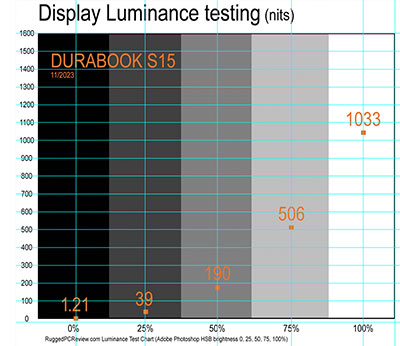 A display quality that we consider very important are the horizontal and vertical viewing angles. The DURABOOK S15 display has near perfect horizontal and vertical viewing angles, and is a definite improvement over the last S15 we tested that was still affected by chromatic aberrations and color shifting as you changed the vertical viewing angle. That makes a BIG difference.
A display quality that we consider very important are the horizontal and vertical viewing angles. The DURABOOK S15 display has near perfect horizontal and vertical viewing angles, and is a definite improvement over the last S15 we tested that was still affected by chromatic aberrations and color shifting as you changed the vertical viewing angle. That makes a BIG difference.
Glossy displays continue to rule in consumer notebooks and tablets because they "pop" indoors and in environments with few reflections, but matte or semi-matte displays can be better outdoors where they diffuse light in a controlled manner, making it easier to view them under the typically high-contrast outdoor lighting conditions.
We appreciate that the S15 display surface is semi-matte rather than the high gloss of most consumer notebooks. That means fewer harsh, distracting reflections outdoor. However, since matte displays diffuse rather then reflect light, they can appear slightly muted/softened when viewed from certain angles. As is, overal what we can report is that the S15's display is looks great, with vibrant colors, and thew 1000 nits version we tested is definitely bright enough for just about any outdoor use.
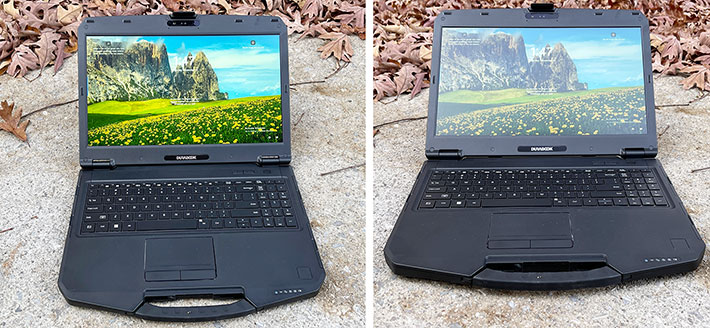
How rugged is the DURABOOK S15?
The well-chosen "DURABOOK" brand name invokes connotations such as "tough," "durable," "reliable" and, well, "rugged", even though the S15 is technically a "semi-rugged" design and the company refer to it as such. There are no official standards on what, exactly, defines "rugged" or "semi-rugged" or even "durable" or "business-rugged" or whatever else the industry has come up with. Even the often cited MIL-STD-810H military testing standard really only describes procedures for a variety of environmental and durability tests. As far as we're concerned, "rugged" machines are fully sealed against the elements, "semi-rugged" ones aren't. And rugged gear generally uses heavier construction and materials, and is specifically designed to hold up against a larger number of environmental and operational threats.
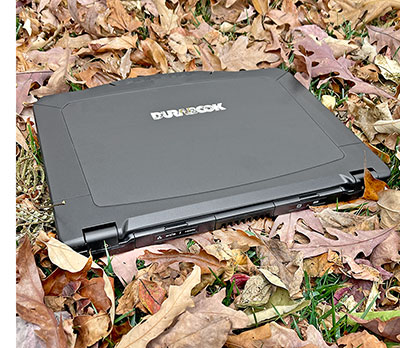 As is, the DURABOOK S15 spec sheet claims MIL-STD-810H certification for having passed drop, shock, vibration, dust, altitude, high/low temperature and humidity tests.
As is, the DURABOOK S15 spec sheet claims MIL-STD-810H certification for having passed drop, shock, vibration, dust, altitude, high/low temperature and humidity tests.
What exactly that all means requires a detailed look at every single test the unit has passed in a ruggedness testing lab, what the parameters were, and what version the version of the MIL-STD used for the tests requires. For example, as is, the original S15 only claimed resistance to a 2-1/2-foot drop, the 2019 predecessor of the current unit, claimed a 3-foot drop, and this latest version a very respectable 4-foot drop.
The difference between 2-1/2 feet and 4 feet is substantial. 2-1/2 feet means falling off a desk. 4 feet means dropping it from chest hight walking in the field. What changed? The switch from rotating hard disks to solid state memory doubtlessly made units less prone to failure. Materials have changed, designs, and the company has more and more experience.
For vibration resistance — which is a very important factor in vehicle-mounted deployments — the S15 passed the testing per MIL-STD-810H, Method 514.8, Table 514.8C-I, Category 4 — Common carrier, 2 hours/axis, operating which tests resistance to vibration using standard laboratory shakers, slip tables, and fixtures.
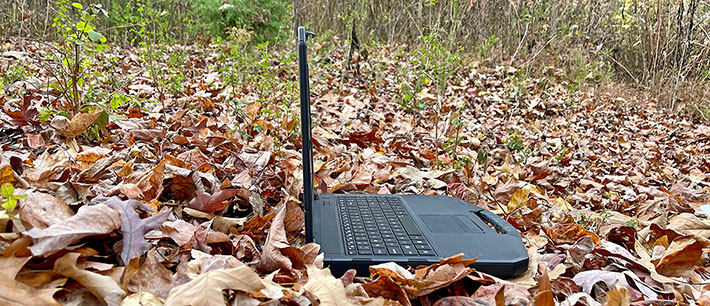
On the sealing front, the DURABOOK S15 still rates an IP5X, where the "5" means the device is protected against dust, but with limited, non-harmful deposits permitted. The "X" says there is no rating indicating protection against liquids. What this means is that instead of water-proofing the entire housing, which requires a heavier, more complex and more costly design, the company concentrated on spill resistance, which is usually the primary source of damage through liquids. That said, some of the semi-rugged competition now claims IP53, where the 3 stands for being able to handle water spray from top.
The ability to operate in very high and very low temperatures matters in rugged laptops. Here, the S15 claims a very wide range from -4F to 140F. That covers commercial freezers all the way up to higher than the hottest day ever recorded in Death Valley.
What it boils down to is that the S15 is way more damage-resistant than any consumer or enterprise laptop, but it's not waterproof like a fully rugged laptop and can't quite take the same abuse.
Summary: The DURABOOK S15
The DURABOOK S15 is the latest, most powerful, and most technologically advanced version of a well established line of semi-rugged laptops from one of the industry's most respected and most experienced designers and manufacturers of military-grade mobile computing products.
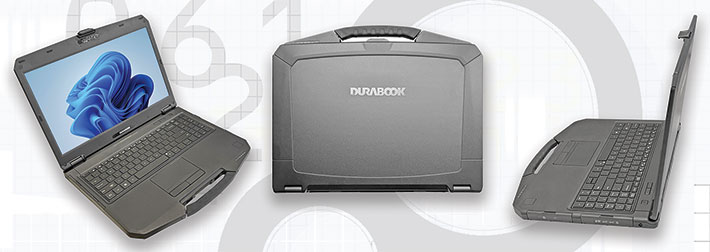
Weighing in at a manageable 5.7 pounds, the S15 is just 1.16 inches thick. It can still be ordered with an internal optical drive, comes with extensive onboard connectivity, and has a nicely integrated carry handle. Built around a very solid magnesium alloy chassis, the S15 presents a high-quality look and feel.
This latest version of the DURABOOK S15 brings a very substantial performance increase via a full four genereration leap from Intel's 8th to 12th generation of Core processors. Add to that a switch to ultra-fast PCIe NVMe solid state disk and DDR5 RAM, and we're talking a very quick machine with state-of-the-art performance.
The DURABOOK S15 has a large 15.6-inch 16:9 aspect ratio display with full 1920 x 1080 pixel HD resolution that remains usable outdoors without much reflection and glare. There is no touch screen. The display surface is semi-matte, which makes it more pleasant to use than a glossy screen. The display has near 180 degree horizontal and vertical viewing angles. With the 1000 nits Dynavue option, the display is very bright.
Even though the DURABOOK S15 is a semi-rugged and not fully rugged design, it is an exceptionally well constructed machine. Its magnesium alloy chassis should hold up for a long time, and there is plenty of shock-mounting as well as lots of internal protection. However, while the unit can handle spills onto its keyboard and such, it is not waterproof (there are open cooling vents to inside on side and bottom).
With its — for a full-size semi-rugged design — remarkably light and slender design and build, the DURABOOK S15 represents a contemporary laptop computer that offers both very good performance and exceptional value. And it comes in an elegant, attractive package that's significantly tougher than standard consumer laptops and should hold up well in daily use. -- Conrad H. Blickenstorfer, November 2023
|
DURABOOK S15 Specifications
|
| Added/changed |
Full review 11/2023
|
| Type |
Semi-rugged notebook
|
| Processor |
Intel "Alder Lake" 12th generation Core i7-1255U (2P and 8E cores) or
Intel "Alder Lake" 12th generation Core i5-1235U (2P and 8E cores) |
| CPU speed |
Core i7-1255U: up to 4.7GHz, E-core up to 3.50GHz
Core i5-1235U: up to 4.4GHz, E-core up to 3.30GHz
|
| CPU TDP |
Core i7-1255U: 15/55 watts
Core i5-1235U: 15/55 watts
|
| OS |
Windows 11 Pro
|
| Graphics |
Intel Iris Xe Graphics; optional NVIDIA® Quadro T1000 |
| Memory |
8GB to 64GB 4800MHz DDR5 in two sockets
|
| Disk/drive |
256GB up to 2TB PCIe NVMe SSD
Optional 2nd storage either M.2 SATA or PCIe NVMe
Optional 3rd storage M.2 SATA
|
| Display size and resolution |
Semi-matte 15.6" FHD LCD with 1920 x 1080 pixel resolution, est 500 nits, with optional 1000 nits DynaVue display
|
| Digitizer/Pen |
NA
|
| Keyboard |
Standard membrane 96-key, full-scale, spill-proof keyboard with optional LED backlight |
| Media Bay |
Optional DVD super-multi optical drive
Optional 3rd solid state disc
Optional ExpressCard 54
|
| Slots |
1 x microSDXC Card, 1 x Smart Card, 1 x Nano SIM card |
| Housing |
Magnesium alloy case, protective port covers
|
| Temperature |
-4° to 140°F (-20° to +60°C) |
| Humidity |
5 to 95% non-condensing |
| Vibration |
MIL-STD-810H, Method 514.8, Table 514.8C-I, Category 4 - Common carrier, 2 hours/ axis, operating
|
| Enclosure Class |
IP5x, Spill-proof |
| Vibration: Functional |
MIL-STD-810H certified |
| Shock: Transit Drop |
4-foot drop |
| Altitude |
MIL-STD-810H certified operating |
| Certifications |
FCC, DOC, CUS, CE, CB |
| Size (inches) |
14.76 x 10.75 x 1.16 inches (375 x 273 x 30 mm) |
| Weight |
5.73 pounds (2.6 kg) as tested |
| Power |
7.4 Volt 7,600 mAh Li-Polymer 56 watt-hours "12 hrs."
|
| Communication |
Intel Wi-Fi 6E AX211 (802.11ax), Bluetooth v5.3, optional GPS and 4G LTE multi-carier WWAN, optional 5G, optional RF antenna pass-through for GPS, WWAN, and WLAN
|
| Camera |
2.0 megapixel webcam; optional 5MP IR camera for Windows Hello w/ HD MJPEG support
|
Interface |
1 x Thunderbolt 4, 2 x USB 3.2 Gen2 Type-A, 1 x USB 3.2 Gen 2 Type-C with DP support, 1 x 10/100/1000 RJ45, 1 x DB9 RS232, 1 x VGA, 1 x HDMI Type A, headphone, microphone, dock
|
| Price |
Starting at US$1,699 |
| Web page |
DURABOOK S15 web page
|
| Spec sheet |
DURABOOK S15 spec sheet |
| Warranty |
3-year limited warranty standard |
| Contact |
Durabook Americas Headquarters
48329 Fremont Blvd.
Fremont, CA 94538, USA
Tel: (510) 492-0828, (800) 995-8946 tollfree
|






